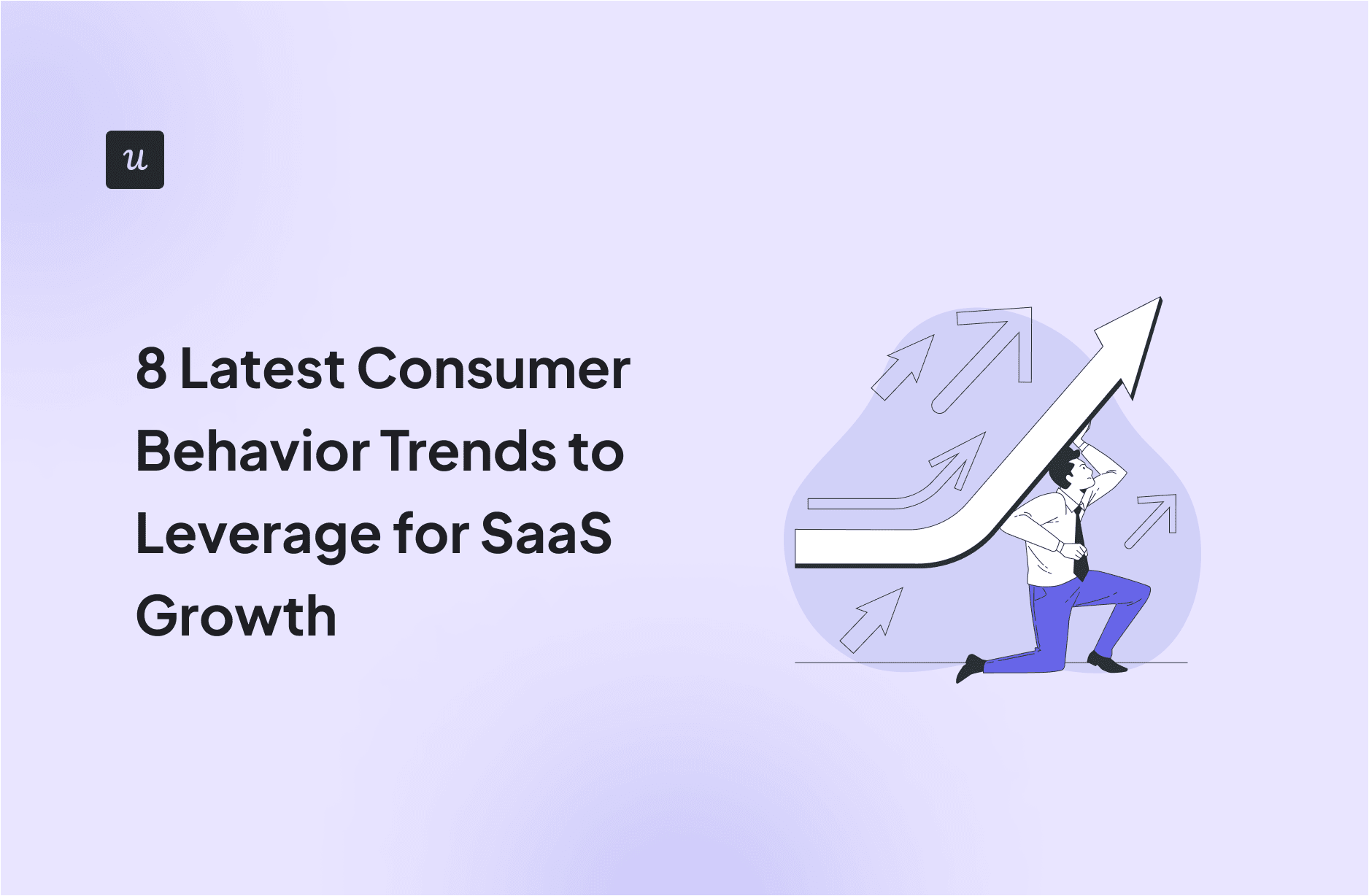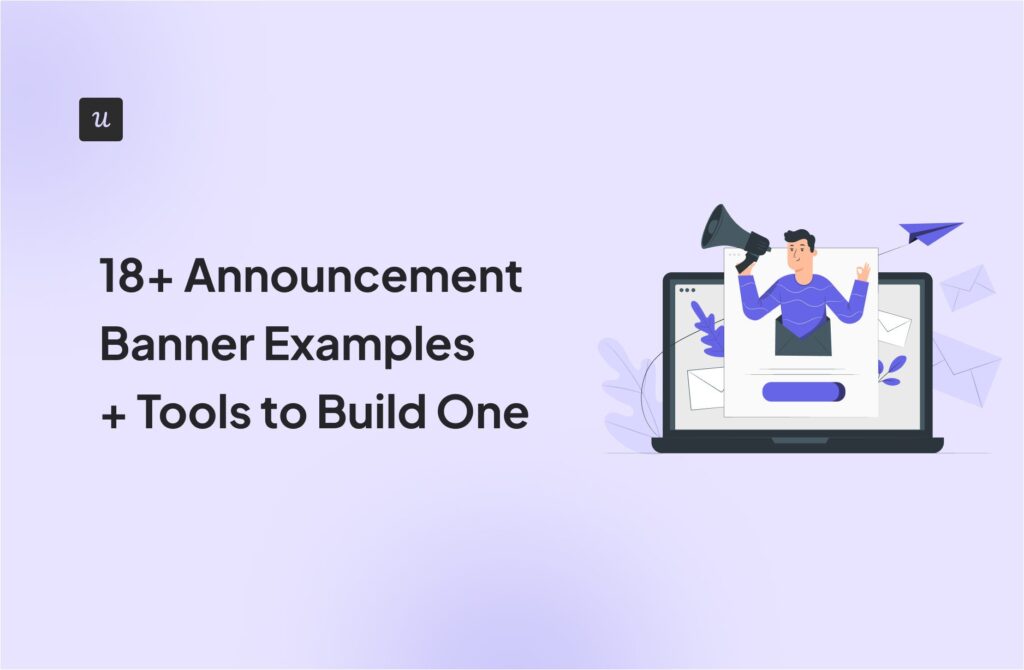
In HubSpot’s consumer behavior trends report, 72% of consumers said they’re more likely to make purchase decisions with a brand they can trust their data with.
But when you think about this and all the trends that are happening right now, how can your business catch up?
Well, let’s explore 8 of the latest trends in the consumer landscape and share some product management strategies you can apply to take advantage of these trends.
Try Userpilot Now
See Why 1,000+ Teams Choose Userpilot

TL;DR
- Gather customer feedback: Actively collecting and acting on customer feedback enhances user experience, builds loyalty, and helps guide product development.
- Collect zero-party data: Collecting zero-party data allows for more accurate personalization and gives customers control over their data—building more trust.
- Personalization: Personalizing the user journey increases customer satisfaction, retention, and revenue—it’s no longer optional.
- AI adoption: Despite mixed trust in AI, its adoption is growing as companies leverage it to increase productivity and improve their offerings.
- Self-service and on-demand support: Customers expect more self-service options and also the ability to quickly reach human support—you should offer both.
- Multi-channel user engagement: Engaging with customers across multiple channels leads to higher retention and more opportunities to close deals, especially in long sales cycles.
- Expand integrations: As SaaS spending grows, customers expect seamless integrations with other tools in their tech stack, making it vital to offer robust integration options.
- Ensure data privacy and security: Ensuring data privacy and security (while giving customers control over their data) is key for building customer trust and satisfying their needs.
- You can take advantage of these trends with Userpilot’s features on in-app surveys, personalization, and resource centers. So if you’re a product manager, why not book a demo to see how you can personalize onboarding without writing code?
1. Customer feedback matters
Companies that collect customer feedback have the advantage of putting customers on their side.
In a Brightlocal survey, 69% of consumers said they’d make buying decisions for a product with written reviews that describe a positive experience, while 88% said they’d use a business that replies to all of its reviews.
Today’s consumers expect to be heard. Thus, listening to users is not just to attract more customers, but also to guide product development, enhance user experience, and cultivate loyal customers.
How to leverage this insight?
- Actively collect feedback through in-app surveys—even better if you can trigger them based on user interactions.
- Engage with customers on social media, review platforms, subreddits, and forums—address all their concerns and hold the responsibility.
- Implement feedback-driven changes and communicate these updates to users to close the feedback loop. For instance, if your customers are concerned about your sustainable practices, you can communicate back with an announcement to address it.
- Use feedback data to prioritize product features that align with customer needs. If possible, create a public roadmap where you can do this in one platform.

2. Zero-party data gains popularity
Zero-party data—data that customers intentionally share with a brand—is gaining traction as a reliable substitute for third-party data and a source for personalization.
This is because—unlike third-party data—zero-party data offers more accuracy and builds trust with customers by giving them control over what they share.
In fact, according to eMarketer’s surveys, 73% of customers expect companies to understand their unique needs and expectations, while more than half expect their offers to be personalized.
This data means that it’s worth collecting zero-party data to offer a personalized customer experience since it will allow you to meet customer’s expectations—and potentially increase retention.
How to leverage this insight?
- Use a user sentiment tool to collect both qualitative and quantitative zero-party data directly from users. For instance, Userpilot’s auto-capture feature collects raw data automatically, which you can later label and perform retroactive analysis.
- Personalize user experiences based on the data shared by users during their interactions with your platform.
- Develop strategies to encourage users to voluntarily share data—such as triggering CSAT surveys after a customer service interaction.

3. Personalized experience is a Must
Personalization has moved from a nice-to-have to an essential component of the user experience.
In Segment’s latest report on personalization, 80% of executives estimated that customers spend 38% more when they receive a personalized experience.
For SaaS companies, this data means that tailoring the user journey to their particular needs doesn’t just make users happier, it also benefits your revenue and the likeliness of retaining high-value customers.
How to leverage this insight?
- Trigger a live demo offer to users who engage with core features during their trial period.
- Use personalized onboarding flows that adapt based on user behavior and preferences.
- Implement dynamic in-app messages that respond to user actions in real-time. This can mean triggering a help tooltip whenever the user seems to be stuck with a feature.

4. AI adoption remains high despite doubt
Only one in three consumers claim to trust AIs (according to HubSpot). But that doesn’t stop it from growing its adoption.
According to McKinsey’s latest reports, 65% of people say that their organizations are already using AI—which is double from last year (this means a 100% increase in usage!).
AI is not just being integrated aggressively into various aspects of SaaS products (e.g. chatbots, predictive analytics, writing, etc.); they’re also being successfully adopted by organizations worldwide, even if it’s just by using ChatGPT.
This immense increase in usage is probably an effort from companies to increase their productivity, as well as release more effective solutions in the market to improve their positioning.
How to leverage this insight?
- Incorporate AI into your product to simplify customers’ jobs-to-be-done (JTBDs) and save time. This can be done by automating tasks that an AI can easily perform, such as writing short texts, organizing data, processing data, etc.
- Implement AI chatbots to improve customer support and engagement.
- Use AI writing assistants, like those in Userpilot, to craft onboarding flows and in-app messages more effectively.
- Find analytics platforms that use AI to enable predictive analytics.

5. Consumers want both self-service and on-demand support
In recent years, the general wisdom about customer service is that customers prefer self-service support over reaching out to a support agent.
This is taken as fact since 95% of consumers place great importance on self-service customer service (according to NICE’s CX report), plus 81% of them expect to receive more self-serve options such as in-app resource centers, chat, social media, and more (suggesting that they want more on-demand support).
This is especially true for simple issues and minor obstacles, but what if the user can only solve their problem with a human agent?
In this case, not being able to reach out to a human agent is the most frustrating part for 30% of customers—meaning that while they do try to solve problems on their own, they still expect to get in touch with a human agent quickly when they need it.
For your company, it’s not only important to keep expanding your self-service options (that is, adding more channels where users can reach out for help), but also to make it easy for customers to get human help when they need it.
How to leverage this insight?
- Create an in-app resource center that offers both self-service options and support tickets.
- Implement chatbots that can handle basic queries while seamlessly handing them over to human agents when needed.
- Allow customers to reach out for help on multiple channels without putting any obstacles. These can include live chat, social media, WhatsApp, email, and inside your app.

6. Maintaining multi-channel user engagement is crucial
Omnichannel campaigns have 90% higher retention rates than single-channel ones.
These days, the same customer can be present on multiple platforms at the same time. Meaning it’s no longer about focusing on “one” channel—but on the right channels.
SaaS companies must not only expand their presence on multiple channels, but also double down on communicating, promoting themselves, and engaging with customers wherever they are (especially if your company has long sale cycles).
This way, customers can start doing business with you on one channel, and close a deal on another. And as a result, increase the quantity and the value of your customers.
How to leverage this insight?
- Use platforms that enable effective customer lifecycle management across multiple channels. Make sure it can integrate all the data in one place or that you can export it to other platforms. For instance, you can export user behavioral data from Userpilot to email platforms to send contextual email campaigns.
- Ensure that all customer-facing teams have access to the same user data to maintain consistency in interactions.
- Use automation tools like Zapier to trigger promotions, announcements, and sales follow-ups on channels like email, SMS, push notifications, etc.

7. The demand for integrations is Increasing
A Vendr research showed that companies under 100 employees have increased their SaaS spend by 377% from 2020 to 2022 (and those with up to 500 employees have also duplicated their expenses).
As the SaaS ecosystem grows, so does the demand for integrations. This data only shows how much need your customers have for integrating your product with the rest of their tech stack.
Not having options means that your customer will face friction once they learn that they need to find a workaround to streamline their workflows—reducing your product’s value in the market.
How to leverage this insight?
- Enable seamless integration with tools across different categories of a tech stack.
- Prioritize building integrations with popular tools that your customers are likely already using. Popular examples are HubSpot, Salesforce, Slack, Zendesk, Google Analytics, etc.
- Offer APIs that allow customers to create custom integrations based on their specific needs.

8. Data privacy and security are important
Consumers continue to be increasingly concerned about data privacy and security.
This is because of data breaches becoming more common, sophisticated cyberattacks, and the negative sentiment toward irrelevant ads showing up everywhere due to retargeting.
How should we deal with customers in this situation?
Well, HubSpot’s report on consumer trends showed that 75% of people want to control how their data is used, what data is shared, and to whom it is shared.
This means that ensuring data security and compliance is not enough, you must provide means for customers to feel more agency over their data—and build customer trust in the process.
How to leverage this insight?
- Acquire security certifications, such as SOC 2 or ISO 27001, to demonstrate your commitment to data protection.
- Ensure data transparency by clearly communicating how customer data is collected, used, and stored.
- Implement robust data encryption and regularly update your security protocols to protect user data.
- Collect more zero-party data and use less third-party data—and communicate it.
- Send surveys and add short explanations on the way you intend to use their response. For example, if you ask them about their job title, explain that you’re going to use that data to personalize the onboarding experience to make it more relevant to their job.

Conclusion
Understanding and adapting to the latest consumer behavior trends is an everyday juggle for SaaS businesses.
If there’s a common theme running through these trends, it’s the growing importance of personalization, convenience, and ethical considerations in the consumer’s decision-making process.
That said, you can take advantage of these trends with Userpilot’s features on in-app surveys, personalization, and resource centers. So if you’re a product manager, why not book a demo to see how you can personalize onboarding without writing code?








